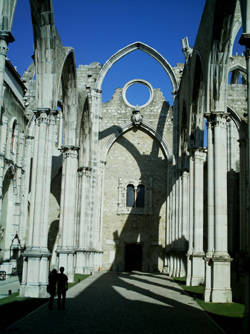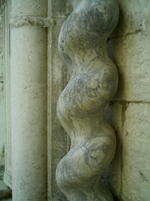 I watched a lot of horror films when I was young and adored the extravagant Vincent Price. I devoured Edger Allen Poe and languished in Wuthering Heights. I can hold my hands up and admit I was a Goth in my teen years and still have a predisposition to wearing black, green and purple and a have love of ‘epic’ music.
I watched a lot of horror films when I was young and adored the extravagant Vincent Price. I devoured Edger Allen Poe and languished in Wuthering Heights. I can hold my hands up and admit I was a Goth in my teen years and still have a predisposition to wearing black, green and purple and a have love of ‘epic’ music.
It was on my first trip to Lisbon when I spied the gothic ruins of the Carmo Convent (Convento do Carmo) for the first time. I was gazing out across Lisbon from the walls of Castelo de São Jorge and a Brazilian man began to point out the sites to me. Even from that far away, I could see the magnificent ruins etched a beautiful silhouette into the skyline. I spied it once again, looking up from Praça Rossio, the arches striking against the blue sky yet hiding the mysteries within its walls.
So on my last trip over, I made a point of making a proper visit to Carmo. Situated in Baixa it is most easily reached by a trip up the Santa Justa Elevador which will bring you up to Largo do Carmo. Largo do Carmo is a pretty little square at the front of the Convent where elderly men gather around stone tables to play cards and people sip coffee in the sunshine. It is amazing to think that this quiet square was one of the focal points of the political revolution in 1974. People carrying carnations persuaded the soldiers upholding the dictatorship to stand aside by placing flowers in the barrels of their guns. Perhaps it is fitting that the grounds around this ancient church witnessed one of the most peaceful revolutions in history.
It costs €2.5 (circa 2007) to enter the ruins. There wasn’t a soul there as I walked down the steps and out into the roofless nave. The place was absolutely silent and the blazing sun cast stark shadows. I gazed up at the awe-inspiring arches that loomed above me and squinted at the glaring white stone. Whatever faith or lack of faith the vistor has, it is impossible not to experience an all pervading sense of peace. It’s easy to imagine nuns serenely in prayer and whispered incantations.
I’m not a Christian, I’ve always been drawn to older religions and practices but Carmo felt like one of those places that has always been sacred; like the land itself was awake with divinity. I remember having this same experience at Glastonbury Abbey – of all the Pagan places I had visited, the Abbey strangely had the most effect upon me. It is said that our old churches were built on ancient places of power, ley lines and springs and temples to old Gods. It makes sense that humankind is drawn to worship in places that its ancestors also sanctified.
So I wandered through the Nave that had become a garden, trailing my fingers across the stone and taking in the marvels of marble and sculpture. Gargoyles stared out from the places in the walls both guarding me and watching me. There were giant columns of stone, huge archways, figureheads and statues.
After a time I entered the main museum at the far end of the nave. Three giant lanterns hung beneath a vast domed ceiling and all around were tombs. I wondered if they were still occupied. Walking into the next room there was no such ambiguity. Shrunken heads and mummies made up part of the collection. The heads seemed impossibly small yet the hair was undeniably human.
On into the next room and there was a maquet of how the church would have looked before the great earthquake that brought down its roof. Looking up in each room I spied intricate azulejos panels adorning the walls. Finally I reached the small museum shop which had the atmosphere of a library. I crept across the floor to the window to gaze out across the wonderful view of Lisbon.
It’s funny, I could have sworn I’d already written this entry. As I wrote the first few lines I had a curious sense of deja-vu. I even checked my archives just to make sure before I posted this and even now I am not entirely convinved I haven’t already written this piece!
Perhaps a little part of the convent has remained with me. The Carmo ruins are a stark reminder of the power of nature and the power of prayer as well as a curious place where time has stood still. One can step in and out of the past and the future in a heartbeat and find that when it comes to peace, it is the same in any era.
Opening Times (updated 2015 from a comment by a website visitor – thank you!)
May – September – 10am to 7pm
Oct – Apr – 10am to 6pm
During the summer, the museum is open from 10am to 10pm every Thursday.
CLOSED ON SUNDAYS
Prices:
3,50€ normal ticket
2,50€ students and over 65



7 comments for “The Gothic Ruins of Carmo Convent”